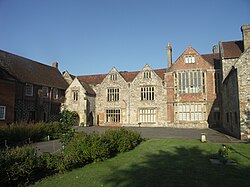 | |
 | |
| Established | 1860 |
|---|---|
| Location | The King's House, Salisbury, Wiltshire, England |
| Coordinates | 51°03′52″N 1°48′00″W / 51.0645°N 1.8001°W |
| Type | History museum |
| Director | Adrian Green |
| Website | www |
The Salisbury Museum (previously The Salisbury and South Wiltshire Museum) is a museum in Salisbury, Wiltshire, England. It houses one of the best collections relating to Stonehenge and local archaeology.[1]
The museum is housed in The King's House, a Grade I listed building,[2] where King James I of England was entertained in 1610 and 1613. Set in the surroundings of the Cathedral Close, the museum faces the west front of Salisbury Cathedral. Previously at 40-42 St Ann Street,[3][4] where it had been founded in 1860[5] by Dr Richard Fowler, FRS, it transferred to its current site in 1981.[6]
The original three-storey building, with mullioned and transomed windows, ornate plaster ceilings and a fine oak-balustraded staircase, houses the main temporary exhibition gallery with the ceramics gallery above. The arms of James I's eldest son, Henry Frederick, Prince of Wales, can be seen in a window in the Wedgwood gallery upstairs.
The director of the museum is Adrian Green. He is supported by chief operating officer Lucy Bridal.

- ^ "Salisbury Museum". Art Fund. 2016. Retrieved 24 February 2016.
- ^ Historic England. "The King's House (College of Sarum St Michael) (1355814)". National Heritage List for England. Retrieved 29 February 2016.
- ^ "Photo: Salisbury, Museum in St Ann Street 2004". www.francisfrith.com. Retrieved 1 July 2020.
- ^ Historic England. "Salisbury Museum, 40 and 42, St Ann Street (1258828)". National Heritage List for England. Retrieved 1 July 2020.
- ^ "Question: Rotunda in the former museum in St Ann Street". Wiltshire Community History. Wiltshire Council. 4 July 2011. Retrieved 1 July 2020.
- ^ "Collections Development Policy 2014" (docx). The Salisbury and South Wiltshire Museum Trust. November 2014.